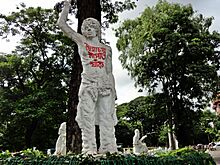Noor Hossain facts for kids
Quick facts for kids
Noor Hossain
|
|
|---|---|
| নূর হোসেন | |

Hossain wearing the words "Let tyranny die!" at a protest for democracy, minutes before his death. Photographed by Dinu Alam.
|
|
| Born | 1961 East Pakistan
|
| Died | November 10, 1987 (aged 26) Dhaka, Bangladesh
|
| Cause of death | Shot by firearms by the Bangladesh Police |
| Resting place | Jurain, Dhaka |
| Monuments | Noor Hossain Square (formerly Zero Point) |
| Nationality | Bangladeshi |
| Known for | Being a symbol of opposition against Ershad's government and later as a symbol for the democracy movement in Bangladesh |
| Political party | Awami Jubo League |
| Parent(s) | Mujibur Rahman (father) Marium Bibi (mother) |
| Relatives | Ali Hossain (brother), Delwar Hossain (brother) |
Noor Hossain (also rendered as Nur Hossain; Bengali: নূর হোসেন, romanized: Nūr Hōsēn; 1961 – November 10, 1987) was a Bangladeshi activist who was killed by the Bangladesh Police on November 10, 1987, while protesting against President Hussain Muhammad Ershad near Zero Point in Dhaka, Bangladesh. Zero Point was later renamed Noor Hossain Square and the anniversary of his death is officially commemorated each year as Shohid Noor Hossain Day. He is one of the most widely known martyrs of Bangladesh's pro-democracy movement.
Contents
Early life
Hossain's ancestral home on his father's side was in the village of Jhatibunia, which is located in Mathbaria Upazila, Pirojpur District. His father, Mujibur Rahman was an autorickshaw operator. His family moved to 79/1 Banagram Road, Dhaka after the Bangladesh Liberation War in 1971. Noor Hossain attended Radhasundari Primary School, which was also on Banagram Road. When he was in 8th grade at Graduate High School, Dhaka, Hossain quit school because of poverty. He was admitted to a motor driving school and received training in driving like his father. Interested in politics, Hossain became the publicity secretary of the Banagram unit committee of Dhaka City Joubo League. He was neither well-off nor highly educated but he embodied the struggle of common people of the country, and has become a public symbol.
Dhaka Siege
On November 10, 1987, political opponents came together for what they called a "Dhaka Siege" (Dhaka Blockade) to demand an end to the rule of President Hussain Muhammad Ershad based on violations of democracy. Although he had been in power since 1982 through a coup d'état, he won the October 1987 election, but opponents charged it was a fraud. The Awami League and Bangladesh National Party united in opposition against Ershad's rule. One opposition demand was an election of the National Assembly under a non-partisan caretaker government. The rally turned violent, and several leaders and protesters including Noor Hossain were killed in riot conditions; several hundred were also injured. Noor Hossain was among three Jubo League members killed at a protest rally. The other two were leaders Nurul Huda Babul and Aminul Huda Tito. In the aftermath, the opposition called for a nationwide protest strike on November 11 and 12.
Hossain is now associated in Bangladesh with anti-autocracy and pro-democracy. At the time he was shot, his body carried several slogans in white paint. He wore the slogan "Down with autocracy" (Sairachar nipat jak) on his chest, and on his back, he had written the slogan "Let Democracy Be Free" (Ganatantra mukti pak). His death raised the visibility of opposition sentiment directed against the Ershad government.
Ershad was removed from office on December 6, 1990 as a result of the mass movement that grew from the Dhaka Siege. After Ershad left office, Khaleda Zia of the BNP was elected as Bangladesh's first female prime minister, and a year later the government established a national date to commemorate the event. It was first called the "Historic November 10 observance", but the Awami League supported the name "Noor Hossain Day" by which it is known today. Ershad's Jatiya Party became part of the Awami League coalition after his removal, and Ershad later apologised for Hossain's death. The Jatiya Party does commemorate the day but refers to it as "Democracy Day" (Bengali: Ganatantra Dibash).
Noor Hossain and the square remained significant for protesters after Hossain's death in 1987 and Ershad's removal in 1990. In 1993, the Awami League led protesters to the square on the occasion of the November 10 anniversary against the BNP government, which also provoked a reaction from the police.
In 1996, Ershad officially apologised for Hossain's death before parliament and also to Hossain's father. Ershad maintained his apology but also criticised the opposition for using Hossain as a symbol against his government.
Gallery
See also
 In Spanish: Nur Hossain para niños
In Spanish: Nur Hossain para niños







